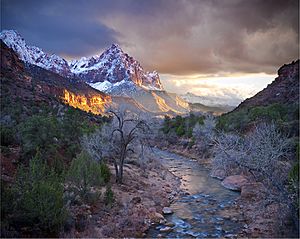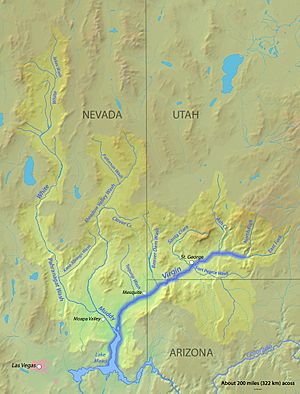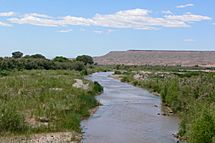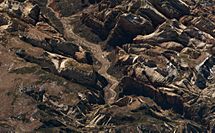Virgin River facts for kids
Quick facts for kids Virgin River |
|
|---|---|

Virgin River in Zion National Park
|
|

Map of the Virgin River watershed
|
|
| Other name(s) | Virgen River, Rio de la Virgen |
| Country | United States |
| State | Nevada, Utah, Arizona |
| Physical characteristics | |
| Main source | confluence of East Fork and North Fork Navajo Reservoir, Dixie National Forest, Utah 3,763 ft (1,147 m) 37°9′44″N 113°0′51″W / 37.16222°N 113.01417°W |
| River mouth | Colorado River Lake Mead, Lake Mead National Recreation Area 1,204 ft (367 m) 36°8′46″N 114°24′59″W / 36.14611°N 114.41639°W |
| Length | 162 mi (261 km) |
| Basin features | |
| River system | North and East Forks Virgin River |
| Basin size | 12,250 sq mi (31,700 km2)approx. |
| Tributaries |
|
| Type: | Wild, Scenic, Recreational |
| Designated: | March 30, 2009 |
The Virgin River is a long river that flows into the Colorado River. It passes through the U.S. states of Utah, Nevada, and Arizona. The river is about 162 miles (261 km) long. In 2009, it became Utah's first "wild and scenic river." This happened during the 100-year celebration of Zion National Park.
Contents
History of the Virgin River
The river got its name from Thomas Virgin. He was part of the first American group to see the river in 1826. This group was led by Jedediah Smith. Smith first called it "Adams River" after the president at the time, John Quincy Adams.
Later, an explorer and mapmaker named John C. Frémont gave the river its current name. Thomas Virgin was injured during the group's journey across the Mojave desert. He recovered but later died on another trip.
The Old Spanish Trail (trade route) followed part of the Virgin River. This trail was used for trade from near St. George to the Muddy River in Nevada.
River's Path
The Virgin River starts in Southwestern Utah. Its source is at the Navajo Reservoir in the Dixie National Forest, north of Zion National Park. It forms where two smaller rivers meet: the East Fork Virgin and the North Fork Virgin River.
The East Fork flows through Mount Carmel Junction, Utah and Parunaweap Canyon. The North Fork comes from Navajo Lake and goes through Zion Canyon in Zion National Park.
The river flows southwest. It passes south of St. George, Utah, where the Santa Clara River joins it. The Paiutes called this spot Tonaquint.
Next, the river crosses the northwestern part of Arizona. It goes through the Virgin River Gorge and past the towns of Beaver Dam, Arizona and Littlefield, Arizona. It then enters southern Nevada near Mesquite, Nevada. Finally, it flows into the Colorado River at Lake Mead. This is about 40 miles (64 km) east of Las Vegas. The last 30 miles (48 km) of the Virgin River forms the northern arm of Lake Mead.
Amazing River Life
Even though the Virgin River flows through a dry area, it has many different plants and animals. Southwestern Utah is where three special regions meet: the Colorado Plateau, the Great Basin, and the Mojave desert.
This area has unique plants and animals that live nowhere else. Without the water from the Virgin River, these species would not survive. The river supports hundreds of wildlife species. Many of them are endangered or are considered sensitive in Utah. The Virgin River Program helps balance human needs for water with protecting this special river system.
Fish of the Virgin River
- Woundfin (Plagopterus argentissimus)
- This fish is a federally endangered species. It grows to about 4 inches (10.2 cm) long.
- The woundfin is one of the rarest fish on Earth. It lives only in a small part of the Virgin River.
- It has large fins and a smooth, scale-less body. This helps it live in fast, muddy water.
- Even though it's small, it looks and acts like a tiny shark. It eats small insects in shallow river areas.
- Woundfin live for only one to two years. They need enough water in the river to survive, especially in hot summers.
- Virgin River chub (Gila seminuda)
- This fish is also a federally endangered species. It can grow up to 18 inches (46.4 cm) long.
- The Virgin River chub is a rare and beautiful fish. It is the top native predator in the Virgin River.
- It has a fast, streamlined body with a sloped head and a humped back.
- Chub eat small fish, insects, and plants. They like deep pools with rocks and debris for hiding.
- Long ago, Virgin River chub were an important food source for Native Americans and early pioneers.
- Desert sucker (Catostomus clarkii)
- This fish is a species of concern in Utah. It can reach 18 inches (46.4 cm) in length.
- The desert sucker gets its name because it "sucks" food from the river bottom.
- It uses its thick, soft lips to scrape and suck plants and insects from rocks.
- During spring, when they lay eggs, desert suckers become very colorful. They get bright orange and black stripes.
- These fish are found only in the Virgin River and its smaller streams in Utah.
- Speckled dace (Rhinichthys osculus)
- This small fish grows to about 4 inches (10.2 cm).
- Speckled dace are very common in western North America. Many of them live throughout the Virgin River.
- They prefer rocky areas but can live in all kinds of river habitats.
- Male speckled dace show off bright red "lipstick" and red fins during breeding season to attract mates.
- Virgin spinedace (Lepidomeda mollispinis mollispinis)
- This is a state conservation species. It grows to about 5 inches (12.7 cm).
- The Virgin spinedace looks and acts like a tiny trout.
- This silvery minnow gets its name from the sharp, spiny rays in its top fin.
- Virgin spinedace are found only in the Virgin River Basin. Unlike the woundfin and chub, they also live in many smaller streams that flow into the river.
- They prefer deep pools and can live in both clear and muddy water.
- Flannelmouth sucker (Catostomus latipinnis)
- This is also a state conservation species. It can grow over 2 feet (64.8 cm) long.
- The flannelmouth sucker is the biggest native fish in the Virgin River. It can weigh over six pounds.
- Its thick, soft lips have taste buds that help it find food on the river bottom. It eats water insects, plants, and other bits of food.
- Flannelmouth suckers usually live in deep, sandy parts of the river. But in spring, many gather in shallow, gravelly areas to lay their eggs.
Southwestern Willow Flycatcher
- Southwestern Willow Flycatcher (Empidonax trailii extimus)
- This bird is a federally endangered species.
- It lives in thick habitats along streams, rivers, and other wet areas.
- At lower elevations, these birds build nests in dense, patchy areas with medium to tall trees and shrubs.
- At higher elevations, they live in thick groups of short to medium-height shrubs near water.
- The bird's preferred homes are almost always near standing or slow-moving water.
- Sadly, many of these river habitats have been destroyed. This has caused a big drop in the number of Southwestern Willow Flycatchers.
- This flycatcher is a migratory bird. It spends winters in Mexico, Central America, and northern South America.
- The flycatcher eats insects. It catches them in the air or picks them from leaves.
Reproduction and Life Cycle
-
- Southwestern Willow Flycatchers arrive at their breeding grounds by mid-May.
- By late May, they build their nests. Nests are usually in a branched tree fork close to the water.
- They typically lay three eggs. The eggs are then kept warm for 12–13 days until they hatch.
Virgin River Gorge
The beautiful Virgin River Gorge is in northwest Arizona. It is just south of the Utah state line. This area is popular for rock climbing in winter. It is known for its steep limestone walls. Interstate 15 follows the Virgin River for several miles through the Virgin River Gorge.
Gallery
- Virgin River
-
Small rock waterfall in the Virgin River's north fork, passing through Zion National Park
-
Satellite image of the Virgin River in Zion National Park
See also
 In Spanish: Río Virgen para niños
In Spanish: Río Virgen para niños





